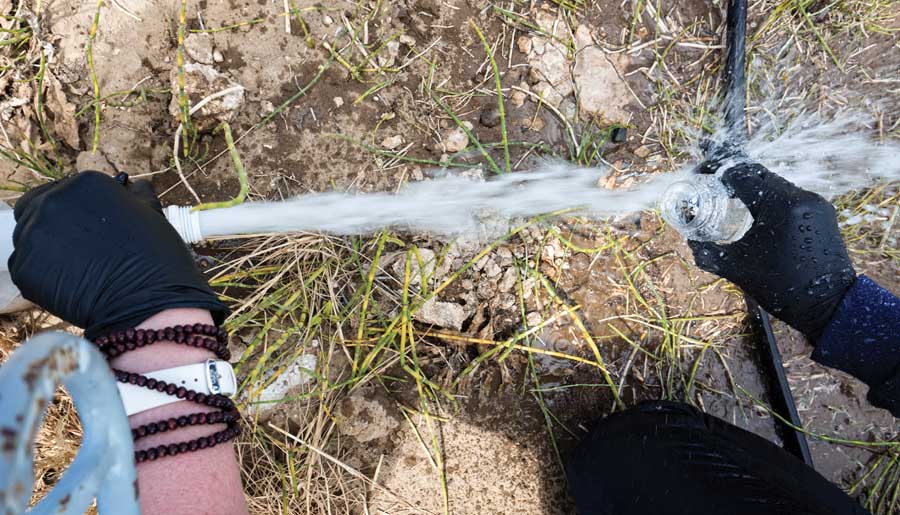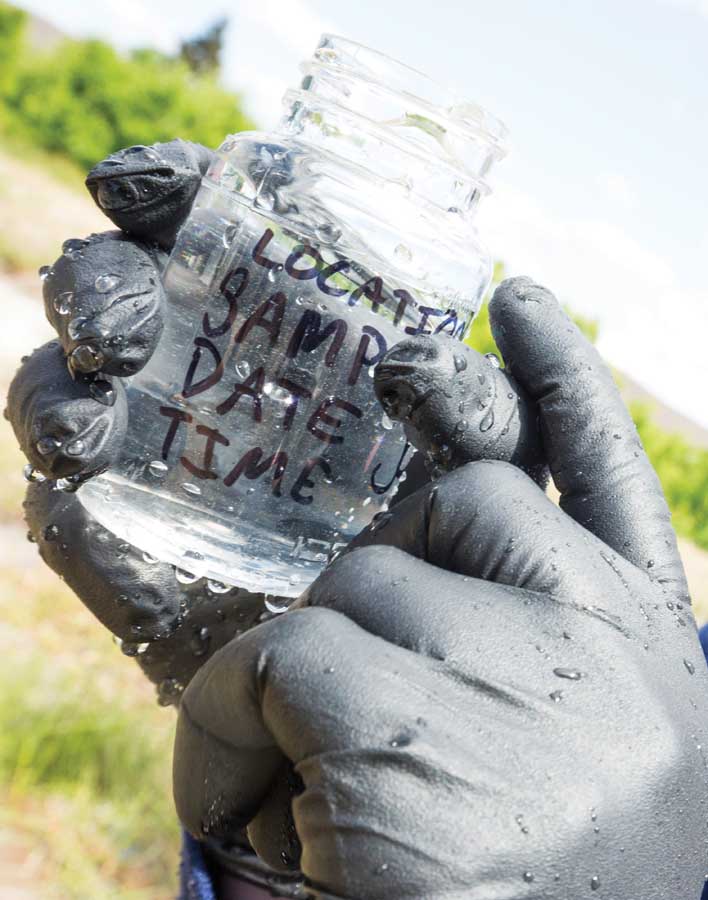
Jennifer Chase of the University of California-Davis recommends holding containers away from equipment to prevent contaminants from entering the bottle or bag, during a demonstration in Selah, Wash., on May 20, 2016. (TJ Mullinax/Good Fruit Grower)
In a recent interview with Good Fruit Grower, UC-Davis researchers Melissa Partyka, Ronald Bond and Jennifer Chase offered tips to growers for taking a water sample.
—Do your homework. Walk the area upstream of your diversion point if you’re drawing surface water from an irrigation canal or stream, or walk around the reservoir on your property if it serves as your water source.
Are there a lot of animals in the area that could contribute to high bacteria levels? Is there runoff, and if so, where? Has the area changed since the last time you walked it? Take notes.
—Be mindful of neighbors. Are they removing an orchard that could drive wildlife to your property or to your upstream water source? When they irrigate, are they discharging upstream of your water source?
If so, it would be good to note when that happens, and avoid sampling then. Again, take notes.
—Secure a sampling site. Find a spot to sample your source water that is easy to access, free of weeds or debris and requires the least effort (a 30-foot walk from the car rather than, say, a 2-mile hike.)
If sampling from a canal, select a site with relatively calm, moving water; avoid stagnant water.
Also avoid sites and times with high turbidity, unless the water is always turbid. If you are sampling piped water, find a convenient spot with a spigot or other hand valve that can be managed at the sampling site, and avoid garden hoses that are full of stagnant water and promote biofilm growth.

Chase shows the proper level of air space that should remain in a testing container when sampling water. The inside of sampling containers must not come in contact with possible contaminants, such as equipment or foliage. Also, don’t touch the inside of the bottle or cap. (TJ Mullinax/Good Fruit Grower)
—Practice. Make reconnaissance trips to your sampling site and practice sampling at your site to develop good habits.
—Be prepared. Make sure you have everything you need: clean gloves, unused containers or containers that have been sanitized in an autoclave, alcohol pads, cooler of ice (not dry ice), paper and pen to make notes. Label your containers ahead of time with the location, date and time of the samples.
—Glove up only when you are ready to begin taking samples, not before leaving the office. Gloves mean you’re ready to start.
—Remove container cap without contaminating the cap or the inside of the container. (Translation: Do not put your fingers inside the cap or container). Secure the cap in a safe place.
—If you are collecting your sample from a surface water source: Facing upstream, collect water with the bottle pointing down, swiping down through the water and up again in a half-moon arc.
Do not skim the surface of the water, and do not disturb upstream sediment or the bottom or sides of the water source.
—For piped water samples, open the water and flush the sample point for two to five minutes. Turn off water and disinfect sampling point with alcohol swab. Turn on water to reflush for a few seconds and fill container without touching the source point.
—Don’t overfill; leave a little head space in the container for lab staff to shake the water sample.
—Recap bottle and place in your cooler.
—Document, document, document. Record notes clearly about your samples and anything unusual you noticed at the site.
With that, you’re ready to send your samples to the lab for analysis. Remember, the researchers note, regulators are not asking you to fix your water quality.
Rather, they are asking you to recognize if there’s an issue with your water quality and to be able to show that you’re taking steps to make allowances for high bacteria counts if your water comes in contact with your crop.
—by Shannon Dininny






Where are some labs we can send our samples to and what problems specifically are the labs looking for (what tests do we ask for).
Hi Don,
I’m not sure where you are located, so I can’t point you to any specific labs. What I can tell you is that you need to request the lab test for E. coli, and according to the current version of the rule, you need to ask for E. coli using method 1603.
I think it would be hard to get a good sample without disturbing the sediment in some cases. It might require some extra work to find an area to gather the water where you can be sure you won’t contaminate the sample. The kind of experience shown by the person writing this article would be something to look for when asking for help having your water sampled.
Hi Jasper,
If the water you are sampling is very shallow, then yes, it would be difficult to sample without touching the bottom. It has been our experience that most irrigation water supplies are >1 foot deep and so can be sampled without touching the bottom. Very shallow water usually indicates low flow, and low flow can lead to increased bacterial counts. Yes, having someone with experience to help can come in handy when you are starting out, at least until you gain confidence. Hopefully you’re in the area when we are giving one of our sampling workshops and we can show you how easy it can be!